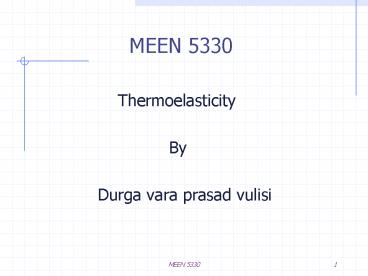Thermoelasticity PowerPoint PPT Presentation
1 / 17
Title: Thermoelasticity
1
MEEN 5330
- Thermoelasticity
- By
- Durga vara prasad vulisi
2
Thermoelasticity
- Introduction and Basic Definition
- The study of the behavior of solids following
certain elastic law is called elasticity,
plastic law - plasticity, thermoelastic law -
thermoelasticity. - When the behavior of a linear elastic solid is
influenced by thermal effects, the stressstrain
relations depend upon the absolute temperature. A
study of such coupled thermal and elastic effects
is called thermoelasticity.
3
Introduction Continued
- Changes in temperatures causes thermal effects on
materials. Some of these thermal effects include
thermal stress, strain, and deformation. - Thermal deformation simply means that as the
"thermal" energy of a material increases, so
does the vibration of its atoms/molecules and
this increased vibration results in what can be
considered a stretching of the molecular bonds -
which causes the material to expand. - If the thermal energy of a material decreases,
the material will shrink or contract.
4
Relation With Fundamental Laws Of Continuum
- We consider only the linear theory based on the
Lagrangian description. - The Kinetic equation of state for a isotropic,
homogeneous, thermoelastic solid is -
(1) - where Tabsolute temperature
- Reference temperature for
the unstressed and unstrained state - Coefficient of Linear
thermal expansion - Lames constants at the
temperature
5
Importance of Coefficient of Thermal Expansion
- Coefficient of thermal expansion is defined by
- For the accurate determination of internal stress
distributions in advanced composite systems, the
elastic and thermal properties of their
constituents must be known. - When Composites are manufactured at relatively
high temperatures, large residual stresses can
exist in the composites after manufacturing due
to the mismatch in the thermal expansion
coefficients .
6
Lames Constants
- µ is normal shear constant , and the other
constant is the bulk modulus less two thirds of
the normal shear constant i.e.
. - These constants are related to more familiar
constants E,? as follows - The and vary with temperature but for
the linear theory we assume them to be constant
over a certain range of temperature the equation
(1) is the familiar Hooke's law in linear
elasticity with temperature term included.
7
Elastic Constitutive Equation
- In general the linear relationship between
components of the strain and stress tensors is
where is a
fourth order tensor. - The isotropic constitutive law using index
notation is given as -
- Which can be written as
- where E is young's modulus,? is Poisson
ratio,dij is kronecka delta
8
Sample problem
- Given the stress state of steel with elastic
constants E207GPa ,?0.3 - find the total strain induced in the steel?
- Solution we know the elastic constitutive
equation as - so
9
Solution continued
- Therefore
- Similarly calculating the other strain
components we get the components of strain as
10
Thermoelastic Constitutive Equation Derivation
- When thermal effects are taken into account
(2) in which
is the contribution from the stress field and
is the contribution from the temperature field
. - is given by due to
change from some reference temperature to T. - Inserting the above equation together with
Hooke's Law -
(3) -
- we get
-
(4) -
11
Duhamel -Neumannn Relations
- Equation (4) is known as Duhamel -Neumannn
relations which may be inverted to get the thermo
elastic constitutive equation (1) - Heat conduction in an isotropic elastic solid is
governed by the Fourier law of heat conduction
where k is thermal conductivity of
the body ,introducing specific heat at constant
deformation we get -
(5) -
12
Coupled Heat Equation Maxwell's Relations
- The internal energy is assumed to be a function
of the strain components and the temperature
T, the energy equation may be expressed in the
form -
which is known as Coupled heat
equation. - Assuming the internal energy to be a function of
the strains and temperature, the differential
change of u due to
changes of
- and T can be written as
- The above equation can be written as
since du is perfect
differential we conclude that -
(6)
13
Summary of the Basic Equations
- Equation (8) is known as Maxwell's relations.
- The basic equations in linear thermoelasticity
are the equations of motion ,the stress
-displacement relations, the kinetic equation of
state and the coupled heat conduction equation
they are as follows in the order stated -
-
-
-
-
14
Sample problem
- Develop the strain energy density for a
thermoelastic solid? - Solution
- The simplest form of Strain energy function
that leads to a linear stress strain relation is
given by U1/2eijsij inserting the thermoelastic
constitutive equation into the strain energy
function gives - U
15
References
- 1 Chang.T.S,Frederick.D, "Continuum Mechanics",
Scientific publishers - 2 http//web.mit.edu/course/3/3.11/www/modules/c
onst.pdf. - 345George,E.Mase,?Continuum mechanics,
Schaums Outlines,TMH - 678910Chang.T.S,Frederick.D,"ContinuumMe
chanics", Scientific publishers
16
Homework problem
- Consider the stress state of steel with elastic
constants E207GPa ,?0.3,k160GPa - find the total thermal strain induced in
the steel when its heated from temperature of
100c to a temperature of 700c?
17
- THANKYOU

